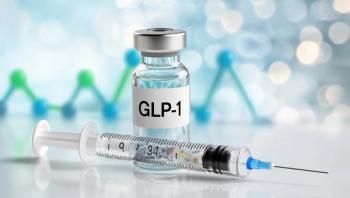
Trial Finds Semaglutide With Lifestyle Intervention Reduces Body Weight by Nearly 15%
In the placebo-controlled trial, 86% of participants who received semaglutide attained at least a 5% reduction in total body weight.
Once-weekly treatment with 2.4 mg of semaglutide plus lifestyle intervention among individuals with overweight or obesity was associated with sustained, clinically relevant reductions in body weight, according to trial results1 published in The New England Journal of Medicine.
Those who received semaglutide, a glucagon-like peptide-1 (GLP-1) analogue sold as Ozempic, had a mean change in bodyweight of –14.9% after 68 weeks compared with –2.4% seen in the placebo group. In addition, 86% of participants who received the treatment attained at least a 5% reduction in total body weight.
Obesity is a chronic disease that can lead to insulin resistance, hypertension, and dyslipidemia, and it is associated with type 2
Lifestyle intervention, consisting of diet and exercise, remains the cornerstone of weight management, researchers wrote, but “sustaining weight loss over the long term is challenging.” Adjunctive pharmacotherapy is recommended for some patients in clinical guidelines, but uptake remains low due to modest efficacy, safety concerns, and cost. Currently, 5 medications are approved for use by the FDA for patients with overweight or obesity, and all require administration once, twice, or 3 times daily.
Semaglutide is approved—at doses up to 1 mg once weekly—for the treatment of T2D in adults and to reduce risk of cardiovascular events in patients with T2D and comorbid cardiovascular disease.
Previous results from a phase 2 trial found that semaglutide induced weight loss in individuals with T2D and adults with obesity. According to authors, the treatment’s impact on weight loss “stems from a reduction in energy intake owing to decreased appetite, which is thought to result from direct and indirect effects on the brain.”
To determine if the treatment, injected subcutaneously, is safe and effective in individuals with overweight or obesity, with or without weight-related complications and absent of T2D, researchers conducted a randomized, double-blind, placebo-controlled trial.
The global phase 3 Semaglutide Treatment Effect in People with Obesity (STEP) 1 program took place at 129 sites in 16 countries throughout Asia, Europe, North America, and South America. It was funded by Novo Nordisk, which produces semaglutide. All participants were 18 years or older, self-reported 1 or more unsuccessful dietary effort to lose weight, and had a body mass index (BMI) of 30 or greater, or a BMI of 27 or greater with 1 or more weight-related condition. Any participant with diabetes or previous surgical obesity treatment was excluded from the trial.
Patients were randomized 2:1 to receive 2.4 mg of semaglutide once a week for 68 weeks or a matching placebo, in addition to lifestyle intervention. Participants initially received a 0.25 mg dose once weekly. After 4 weeks, doses increased every 4 weeks to reach 2.4 mg weekly by week 16, while lower maintenance doses were permitted if participants reported unacceptable adverse effects with the 2.4-mg dose.
Lifestyle intervention included counseling sessions every 4 weeks to help participants adhere to a reduced-calorie diet and increase physical activity (150 minutes per week was encouraged). Daily diet and activity were recorded in a diary, via a smartphone application, or using other tools.
A total of 1961 participants were assigned to receive semaglutide (n = 1306) or placebo (n = 655) between June and November 2018, while 94.3% completed the trial, 91.2% had a body weight assessment at week 68, and 81.1% adhered to treatment. Throughout the study window, “rescue interventions were received by 7 participants in the semaglutide group (2 had bariatric surgery and 5 received other antiobesity medication) and by 13 in the placebo group (3 had bariatric surgery and 10 received other antiobesity medication).”
The majority of participants were White (75.1%) women (74.1%) with a mean age of 46 years and a mean body weight of 105.3 kg. At baseline, mean BMI was 37.9, mean waist circumference was 114.7 cm, and 43.7% of participants had prediabetes. Three-fourths of participants also had at least 1 coexisting condition (hypertension, dyslipidemia, obstructive sleep apnea, or cardiovascular disease).
Analyses revealed:
- Mean change in body weight from baseline to week 68 was –14.9% in the treatment group vs –2.4% in the placebo group for an estimated treatment difference of –12.4 percentage points (95% CI, –13.4 to –11.5; P < .001).
- More participants who received semaglutide achieved weight reductions of 5% or more than the placebo group (1047 [86.4%] vs 182 [31.5%]), 10% or more (838 [69.1%] vs 69 [12%]), and 15% or more (612 [50.5%] vs 28 [4.9%]) at week 68 (P < .001 for all).
- One-third of participants treated with semaglutide lost at least 20% of baseline weight, which is comparable to that seen 1 to 3 years after sleeve gastrectomy bariatric surgery.
- Change in body weight from baseline to week 68 was –15.3 kg in the semaglutide group vs –2.6 kg in the placebo group (estimated treatment difference -12.7 kg; 95% CI, -13.7 to –11.7).
- 89.7% and 86.4% of participants in the semaglutide and placebo groups reported adverse events, respectively.
- More participants in the semaglutide group than in the placebo group (7% vs 3.1%, respectively) discontinued treatment due to adverse events.
Those who received semaglutide also exhibited greater reductions in waist circumference, BMI, and systolic and diastolic blood pressure compared with placebo, and had improved levels of glycated hemoglobin, fasting plasma glucose, C-reactive protein, and fasting lipid levels after 68 weeks. These participants reported greater increases in physical functioning from baseline compared with placebo.
Gastrointestinal disorders, including nausea, diarrhea, vomiting and constipation, were the most frequently reported events and occurred in 74.2% of those who took semaglutide compared with 47.9% of the placebo group. Approximately 10% of those who took semaglutide reported serious adverse events, compared with 6.4% in the placebo group, “with the difference due primarily to a difference between the groups in the incidence of serious gastrointestinal disorders and hepatobiliary disorders,” researchers wrote. In the semaglutide group, 2.6% of participants reported gallbladder-related disorders compared with 1.2% of the placebo group, and those who took semaglutide reported higher rates of cholelithiasis.
Weight reductions achieved with semaglutide were substantially greater at 14.9% compared with weight loss from baseline achieved using approved antiobesity medications, which ranges from
Previous research has found that 3 mg of daily liraglutide (the only GLP-1 receptor agonist
“It is important to note that oral semaglutide has been associated with pancreatitis and, in rodents, with thyroid C-cell tumors, which include medullary thyroid carcinoma,” the authors of an accompanying editorial2 pointed out.
The majority female, White study population marks a significant limitation to the trial in that results may not be generalizable to the wider American public. Researchers also noted the relatively short duration of the trial and the potential that participants “may represent a subgroup with greater commitment to weight-loss efforts than the general population,” presenting further limitations.
In the United States, the prevalence of adult obesity increased from 30.5% in 1999-2000 to 42.4% in 2017-2018, while the presence of severe obesity jumped from 4.7% to 9.2%, according to the
Although several treatments including lifestyle modification, metabolic surgeries, and pharmacotherapies are being developed to combat this trend, research indicates that in less than 10 years,
“Moving forward, head-to-head trials comparing oral GLP-1 agonists with sodium glucose co-transporter (SGLT)-2 antagonists or other weight-loss medications will be necessary,” authors wrote in the editorial. “Given the effectiveness of
References
- Wilding JPH, Batterham RL, Calanna S, et al. Once-weekly semaglutide in adults with overweight and obesity. N Engl J Med. Published online February 10, 2021. doi:10.1056/NEJMoa2032183
- Ingelfinger JR, Rosen CJ. STEP 1 for effective weight control—another first step? N Engl J Med. Published online February 10, 2021. doi:10.1056/NEJMe2101705
Newsletter
Stay ahead of policy, cost, and value—subscribe to AJMC for expert insights at the intersection of clinical care and health economics.















































